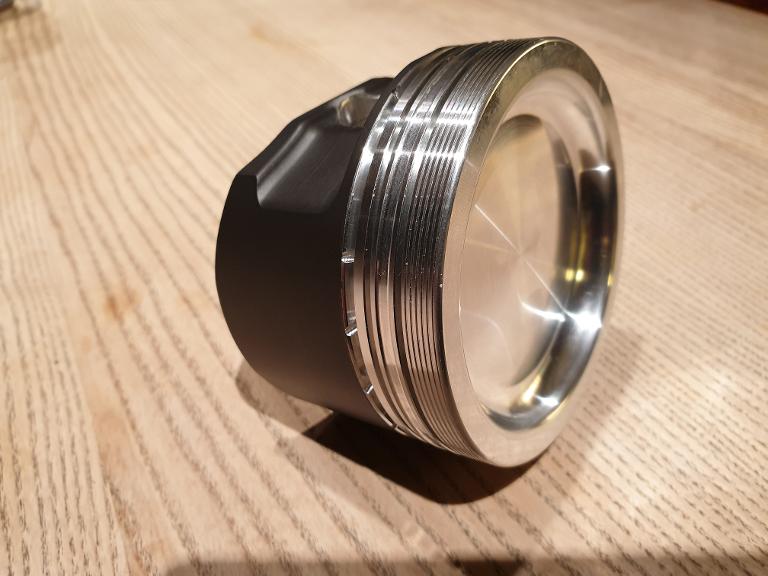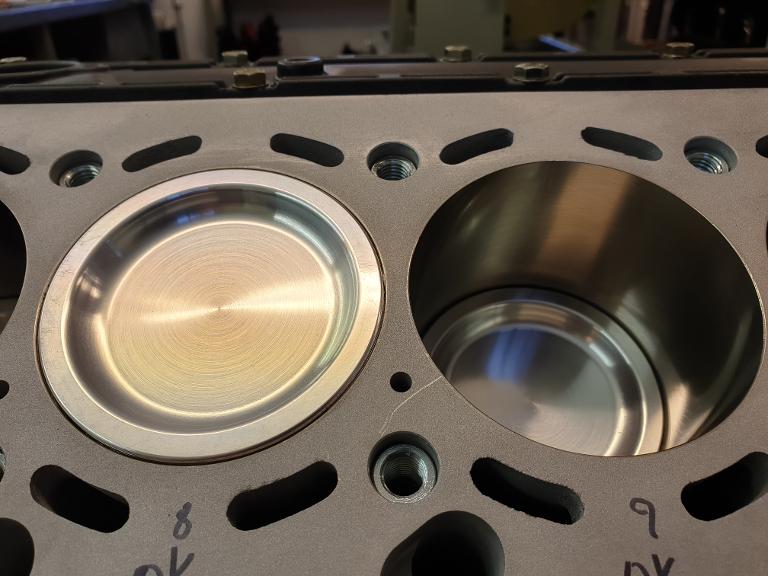Compression ratio
We have deliberately chosen to lower the compression ratio of our engines for several reasons. The pistons are especially designed for our engines by Carillo Pistons, www.cp-carrillo.com and the compression ratio is lowered from OEM standard 10,0 : 1, down to 8,0 : 1. Since these engines as they come from the factory, do not have any form of breathing help, like a turbocharger, supercharger, or similar, the factory has chosen a higher compression ratio to be able to get a higher combustion pressure, and by that, gaining more power, and maybe even a "cleaner" engine. The maximum avaliable power from the normally aspirated M73-B54 is 323 Hp @ 5000 RPM. That is not much to "write home" about, so to speak! It was therefore very clear from the start that this type of engine needed to be either supercharged, or turbocharged. Since a supercharger system is far less complicated than a turbocharger system, and also the fact that an aero engine is more like a stationary engine with small variations in RPM and manifold pressure, we have chosen to use a sentrifugal supercharger to boost our engines. Actually, it is very difficult, even close to impossible to incorporate a turbocharger safely in a P51 Mustang or a Spitfire. The tight space between the cowling and the engine cradle of these aircraft does not allow any tubing of "exhaust size" to be routed down to a turbocharger. The problematic excessive heat from a turbocharger system is also a huge issue that one has to tackle.
The effect of volume
One of the reasons to chose a lower compression ratio is, that one can achieve a more effective combustion. In other words, one can fill up the more "spacious" combustion chamber with more air/fuel than in the room with the higher compression or "tighter" space. It is our opinion, that these "extra" combustion gasses will be quite a bit more effective than the higher combustion ratio alone. In both cases, the cylinder pressure will increase, but it is quite obvious that one will get more "punch" out of the combustion with a higher volume of air/fuel in it.
Detonation, the enemy of the Otto motor
The other important reason to lower the compression ratio, is to reduce the risk of detonation. Detonation, knocking or pinging in combustion engines occur when combustion of some of the air/fuel mixture in the cylinder is not a result of propagation of the flame front ignited by the spark plug, but one or more pockets of air/fuel mixture exploding outside the envelope of the normal combustion front. The air/fuel charge is ment to be ignited by the spark plug only, and at a precise point in the piston stroke. Knocking occurs when the peak of the combustion process no longer occurs at the optimum moment for the four-stroke cycle. The shock wave creates the characteristic metallic "pinging" sound, and the cylinder pressure increases dramatically. Effects that follow from engine knocking range from minor or no consequence to complete destruction.
However, detonation can be prevented by following certain techniques.
- Retarding ignition timing.
- Enriching the air/fuel ratio which alters the chemical reactions during combustion, which again reduces the combustion temperature and increases the margin towards detonation.
- Reducing peak cylinder pressure by reducing the load on the engine.
- Decreasing the manifold pressure by reducing the throttle opening or boost pressure.

Carillo Pistons, 8:1 Compression Ratio


For the curious amongst you, the piston is protruding above the deck with + 0,475 mm / 0,0187 Inch. Obtaining a good "squish" is more important in a normally aspirated engine than in a boosted engine, like the ASE-650 Saga.
Advancing the ignition timing
As you may understand, detonation, can and will occur in any combustion engine. It is just a matter of "pushing" hard enough up against the engine's limits. Pressure and temprature are strongly linked, and are the main factors for detonation to occur. Every engine manufacturer, including Aerosport Engineering, has to know where the detonation limit is, and strive to stay away from it. Detonation is verified during the testing and experimenting phase of the powerplant. By using a few simple tools, together with today's sofisticated engine managment systems, there are several ways of detecting detonation at an early and non destructive point.
By manipulating the engine's ECU (Engine Controll Unit), one can alter the air/fuel mixture ratio wherever it is needed in the "fuel map" to obtain a safe and efficient air/fuel mixture for any RPM and load. The ignition timing is manipulated in the same manner, through an ignition map in the ECU. The big difference in manipulating between the air/fuel mixture ratio and the ignition timing curves, is that the ignition timing is where you will see the most gain in power. Advancing the ignition timing is very enticing, given the quick gain of power. However, the advance has to be made in small steps, sometimes as little as one degree at a time, when pushing the limits towards the point of detonation.

.png?v=1611050572224)
.png?v=1611050431932)
.png?v=1611050548824)
.png?v=1611050119333)
.png?v=1611050465355)
.png?v=1611050452767)
.png?v=1611050558000)
.png?v=1611738745088)
.png?v=1611050528853)